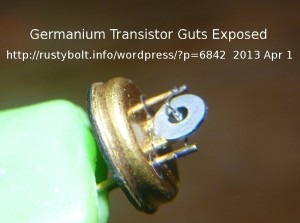 I took this picture by holding a two lens pocket magnifier in front of my point-n-shoot camera. I came out good considering that the magnifying lenses had no color correction. That’s why there’s a slight color fringe at some dark and light points.
I took this picture by holding a two lens pocket magnifier in front of my point-n-shoot camera. I came out good considering that the magnifying lenses had no color correction. That’s why there’s a slight color fringe at some dark and light points.
This is an old germanium transistor from the late ’50s or early ’60s made by Texas Instruments. I filed off the edge around the case and pulled the cap off. The diameter of the whole disk is about 1/8″ or 3mm, which is huge by today’s standards. Today they could get a whole microprocessor in that size disk. The actual transistor chip is the inner disk, and this disk itself is the base of the transistor. The bond wire from the ‘post’ comes over and goes into the blob in the center of the disk, which is the collector. The other side has one that looks almost the same, but it is the emitter.
Germanium has to be put into a hermetically sealed package because the germanium cannot be passivated like silicon. Silicon can be passivated by changing the surface to silicon dioxide, or glass. Then epoxy or plastic can be put over the silicon chip. The first germanium transistors were packaged in plastic, but they went bad as the moisture in the air seeped up through the space between the plastic and the wire leads. The manufacturers then changed to a hermetically sealed metal package. In this case, the metal base, shaped like an upside down pan, is filled with glass, which seals the leads where they go through the glass. Nothing could get through the case once the lid was welded on. I removed this cap years ago, so the chip has been exposed to moisture and air and has most likely quit working shortly after it was removed.